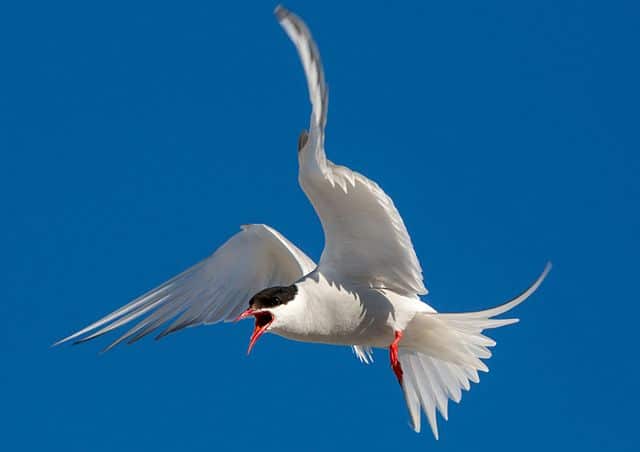A sure sign of spring in northern Europe is the arrival of the Arctic tern, but the warming of the oceans in its nesting grounds in the Northern Atlantic is threatening its very existence. 8 May is World Migratory Bird Day.
The Arctic tern is a great traveller. Its breeding grounds are circumpolar covering the Arctic and sub-Arctic regions of Europe, Asia and North America. In Europe it spends summers from Brittany in the south to Iceland, Greenland and Svalbard in the north. Come autumn in the northern hemisphere it heads for Antarctica where it stays during the northern winter, which is of course summer in the southern hemisphere.

The average life span of the Arctic tern is around 20 years but some live to the mid-thirties. The Arctic Tern is on the Red list of the International Union for Conservation of Nature (IUCN) for threatened species, although at the moment it is categorised as of “Least Concern”.
Currently, about 250,000 Arctic tern couples nest in Iceland.
“The number of Arctic terns in this country has definitely decreased in the past few decades,“ says Guðmundur A. Guðmundsson Animal Ecologist at the Icelandic Institute of Natural History.
The existence of the Arctic tern as well as other migratory sea-birds like the puffin, is threatened by the collapse of sand eel stocks in the seas around Iceland.
“A very likely cause is the warming of the ocean,“ says Guðmundsson. The young sand eels are threatened by the early blooming of algae – too early for them.“
One reason for hope is that the puffin seems to be recovering and hopefully the Arctic Tern will follow suit.
Triple crisis
Inger Andersen the Executive Director of UNEP, the UN Environment Programme says that migratory birds “have a front-row seat to what we at UNEP call the triple planetary crisis of climate change, biodiversity loss and pollution.”
“Climate change is changing and disturbing the migratory patterns of birds. The destruction of the natural world threatens these pollinators, critical for food security and well-being. And pollution whether in waterbodies, land or air, is proving toxic for migratory birds,” says Andersen.
A true globe-trotter

The Arctic tern is a world-record holder for the longest migrations. Annually it migrates from the Arctic Circle to the Antarctic Circle. However, since it doesn´t fly directly from north to south, an individual bird is known to have covered almost 100,000 kilometres or twice the circumference of the planet.
“It is on the move virtually the whole year,” Guðmundsson explains. “It lives for long periods on the ocean and is carried by winds and currents.“
In the case of Iceland, it announces spring in the latter part of April in the North, when it arrives to nest. When the chicks are ready to fledge in August it flies to the south, but not in a straight line, rather in an S-shape trajectory. One of their well-known stop-overs is Cape Town in South Africa in November.
“When it reaches Antarctica it stays close to the ice-brim, and moves gradually eastward. Swedish and Dutch birds go all the way towards Australia, but the Icelandic and Greenland birds return earlier to the Weddell Sea in the Southern Arctic. From there they set off north in March and up to one and a half months later they reach their destination in our country.“
On route to their nesting grounds in Iceland and Greenland they are known to have stop-overs in Brazil and cross the Andes mountain range.
“It is a big adventure,“ says Guðmundsson.
Humans beware

Surprisingly, after this long journey the Arctic Tern lays its eggs in relatively unprotected areas, virtually on the ground. However, the bird is protective of its young and won’t hesitate to attack humans by pecking them with their pointy beaks.
Other birds sometimes nest close to the Arctic Tern to benefit from its aggressive defensive strategy.
World Migratory Bird Day is held twice annually in the spring and the autumn. “Sing, Fly, Soar – Like a Bird!” is the theme of this year’s World Migratory Bird Day on 8 May. The Day highlights a global campaign dedicated to raising awareness of migratory birds and the need for international cooperation to conserve them.
“On World Migratory Bird Day, I call on us to re-double our commitment to addressing the triple planetary crisis and securing the future of the bird song for all,” says Inger Andersen, the Executive Director of UNEP.
Additional links:

